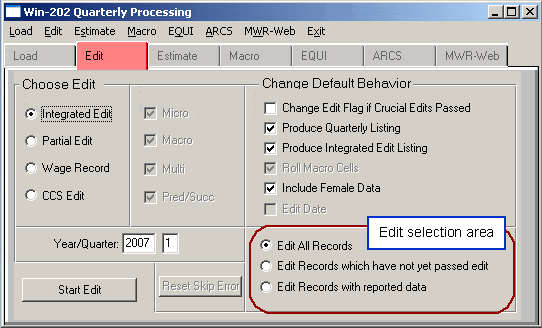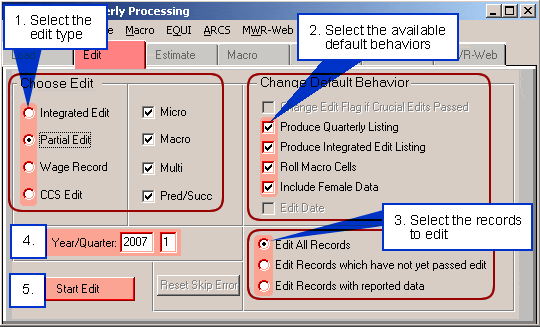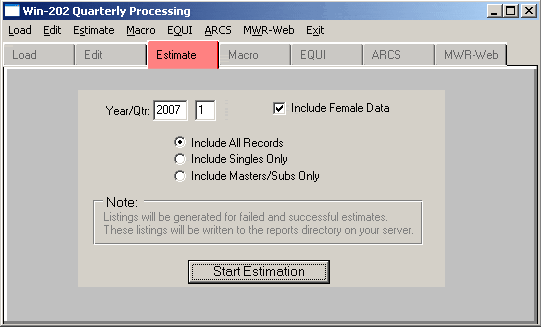Edit Data Tab
Click on the Edit tab and you will discover there are several ways to edit your data in the WIN-202 system. After you roll forward to a new quarter and extract and load data, you should run an Integrated Edit for all records (the default in the Edit Selection Area on your screen).

The different kinds of edits that you may run are as follows:
- Integrated Edit—Edits all Micro, Macro, Multi and Predecessor/Successor data simultaneously. Processing will be done for all unlocked quarters up to and including the current quarter.
- Partial Edit—Allows for selection of some or all of the integrated edits (Micro, Macro, Multi, and Pred/Succ). By default, all edit types have check marks beside them, indicating that those edits will be run. Click on a check mark to remove it and not run a particular edit.
- Wage Record—Checks wage record data against employment and wage data already in the system.
- CCS Edit—Checks 1st and 4th quarter records for a code change supplement.
Descriptions of the Change Default Behavior selections are as follows:
- Change Edit Flag if Crucial Edits Passed—The edit flag is changed to yes if the edits pass without crucial errors.
- Produce Quarterly Listing—Produces a listing of quarterly data errors.
- Produce Integrated Edit Listing—Produces a listing of records with macro and micro errors. It will display macro cells with errors and within it all related micro records with errors.
- Roll Macro Cells—Re-rolls (aggregates) the macro data by county, ownership and industry.
- Include female data—Used if your state tracks female employment and wages.
- Edit Date—Used to edit only those records that changed since the last date an edit was run.
The edit selections are:
- Edit all records (default)
- Edit records that have not yet passed edit (edit flag = yes)
- Edit records with reported data (all indicator = C)
Performing Edits
Each record in your file contains an edit flag. Initially the edit flag is set to "no" because no records have been edited. If you edit a record and the record passes all edits, the edit flag is changed to "yes". If you edit a record and the record does not pass all edits, the edit flag is changed to "no".
If you make changes to a record, the edit flag is changed to "no" to indicate that the record must be edited again. Re-editing again changes the edit flag to "yes". Analysts may bypass re-editing accounts by manually setting the edit flag. You can manually change the edit flag to "yes" only if you have added a comment to a record. See Chapter 3 Screens, Micro Tab section, Comments Radio Button subsection. Note: Running partial edits will not change the edit flags.
To Perform an Edit:
- Click the radio button of the desired edit from the "Choose Edit" area.
- Check or uncheck the box(es) of the desired default behaviors from the "Change Default Behavior" area. Clicking on a check mark removes the default behavior. Some default behaviors are unavailable with certain edits. If the integrated edit is selected, you must roll macro cells. The choice is grayed out and unavailable for de-selection.
- Select the records to edit (i.e., All Records, Records which have not yet passed edit, or Records with reported data) by clicking on the appropriate radio button.
- Enter a year/quarter to edit and press [Tab] after each selection.
- Click [Start Edit] button. A message displays stating the job has begun. The edit batch job can be tracked using the Batch Monitor. See Chapter 6 Administrative for more information on the Batch Monitor.

Note: Running an edit will automatically run the Data Counts Listing (dcountsyymm.userid), which can be found in the Reports folder after the job is complete. See Chapter 7 Reports for more information.
Estimate Data Tab
The Estimate tab is used to estimate data for records with missing data. When running batch estimations, you have the option of including "All Records", "Singles Only" or "Masters & Subunits Only".
To Estimate Data for All Records:
- Input the Year and Quarter desired in the "Year/Qtr" field.
- Click the "Include Female Data" box if you wish to include female data.
- Select the type of records to include: "All Records", "Singles Only", or "Masters/Subs Only".
- Click [Start Estimation] to begin processing. A message will display stating the job has started. You can monitor the job via the Batch Manager. Estimation output will go to the \win202\reports\directory.

Five output files are generated when female data is not included and seven output files when female data is included. These output files are generated regardless of the "Selection Type of Records" chosen. The output files are as follows:
- Multis that passed estimation: ESTMLTPASSYYMDD.ot
- Multis that failed estimation: ESTMLTFAILYYMDD.ot
- Singles that passed estimation: ESTSGLPASSYYMDD.ot
- Singles that failed estimation: ESTSGLFAILYYMDD.ot
- Estimate summary: ESTSUMMARYYYMDD.ot
- Female data that failed estimation: FEMALE-EST-FAIL-YYYY-Q.txt
- Female data that passed estimation: FEMALE-EST-PASS-YYYY-Q.txt
